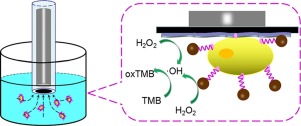Sensors and Actuators B: Chemical ( IF 8.4 ) Pub Date : 2018-01-08 , DOI: 10.1016/j.snb.2018.01.092 Liang Tian , Jinxu Qi , Kun Qian , Olayinka Oderinde , Yingying Cai , Chen Yao , Wei Song , Yihong Wang

|
An ultrasensitive electrochemical circulating tumor cells (CTCs) detection strategy was developed based on magnetic field-induced, targeted separation and enrichment, and reduced graphene oxide/molybdenum disulfide (rGO/MoS2) composites and Fe3O4NPs binanozyme synergistic catalysis for signal amplification. Immunomagnetic beads (Fe3O4NPs) act as both separation and enrichment CTCs and as enzyme mimics with rGO/MoS2 synergistic catalysis for signal amplification in cytosensors for the first time. Notably, rGO/MoS2 composite showed a good electrocatalytic activity towards H2O2 synergistic catalysis with Fe3O4NPs. The utilization of rGO/MoS2 and Fe3O4NPs as electrochemical signal indicator and enhancer to fabricate biosensor could avoid the need for additional redox mediator for detection sensitivity amplification. The immunomagnetic beads were coated on the magnetic glassy carbon electrode (MGCE) surface by inserting a magnet for electrochemical cytosensing fabrication. Furthermore, this cytosensor could be regenerated by simply pulling out the magnet. Under the optimized experimental conditions, the proposed cytosensor exhibited significant analytical performance for MCF-7 circulating tumor cells detection. The proposed electrochemical biosensor detected MCF-7 down to 6 cells mL−1 with a linear range from 15 to 45 cells mL−1 at the acceptable stability condition and reproducibility. With rGO/MoS2 composites, Fe3O4NPs bienzyme mimics and electrochemical immunomagnetic cytosensor fabrication, this strategy possesses the advantages of high efficiency, high sensitivity, low cost and versatility, thus holds great promise for other low-abundance circulating tumor cells detection.
中文翻译:

基于Fe 3 O 4纳米酶和还原型氧化石墨烯/二硫化钼纳米酶的磁场辅助二元酶协同催化的超灵敏电化学细胞传感器
基于磁场诱导的靶向分离和富集,以及还原的氧化石墨烯/二硫化钼(rGO / MoS 2)复合材料和Fe 3 O 4 NPs双anozyme协同催化信号,开发了一种超灵敏的电化学循环肿瘤细胞(CTC)检测策略放大。免疫磁珠(Fe 3 O 4 NPs)既可作为分离和富集的四氯化碳,又可作为酶模拟物,首次通过rGO / MoS 2协同催化在细胞传感器中进行信号放大。值得注意的是,rGO / MoS 2复合材料对铁对H 2 O 2的协同催化具有良好的电催化活性。3 O 4 NP。利用rGO / MoS 2和Fe 3 O 4 NPs作为电化学信号指示剂和增强剂来制造生物传感器可以避免需要额外的氧化还原介体来提高检测灵敏度。通过插入用于电化学细胞传感制造的磁体,将免疫磁珠涂在磁性玻璃碳电极(MGCE)的表面上。此外,可以通过简单地拉出磁体来再生该细胞传感器。在优化的实验条件下,拟议的细胞传感器对MCF-7循环肿瘤细胞检测显示出显着的分析性能。拟议的电化学生物传感器可检测低至6个细胞mL -1的MCF-7在可接受的稳定性条件和可重复性下,线性范围为15至45个细胞mL -1。利用rGO / MoS 2复合材料,Fe 3 O 4 NPs双酶模拟物和电化学免疫磁性细胞传感器的制备方法,该策略具有高效,高灵敏度,低成本和多功能性的优点,为其他低丰度循环肿瘤细胞的检测提供了广阔的前景。 。



























 京公网安备 11010802027423号
京公网安备 11010802027423号